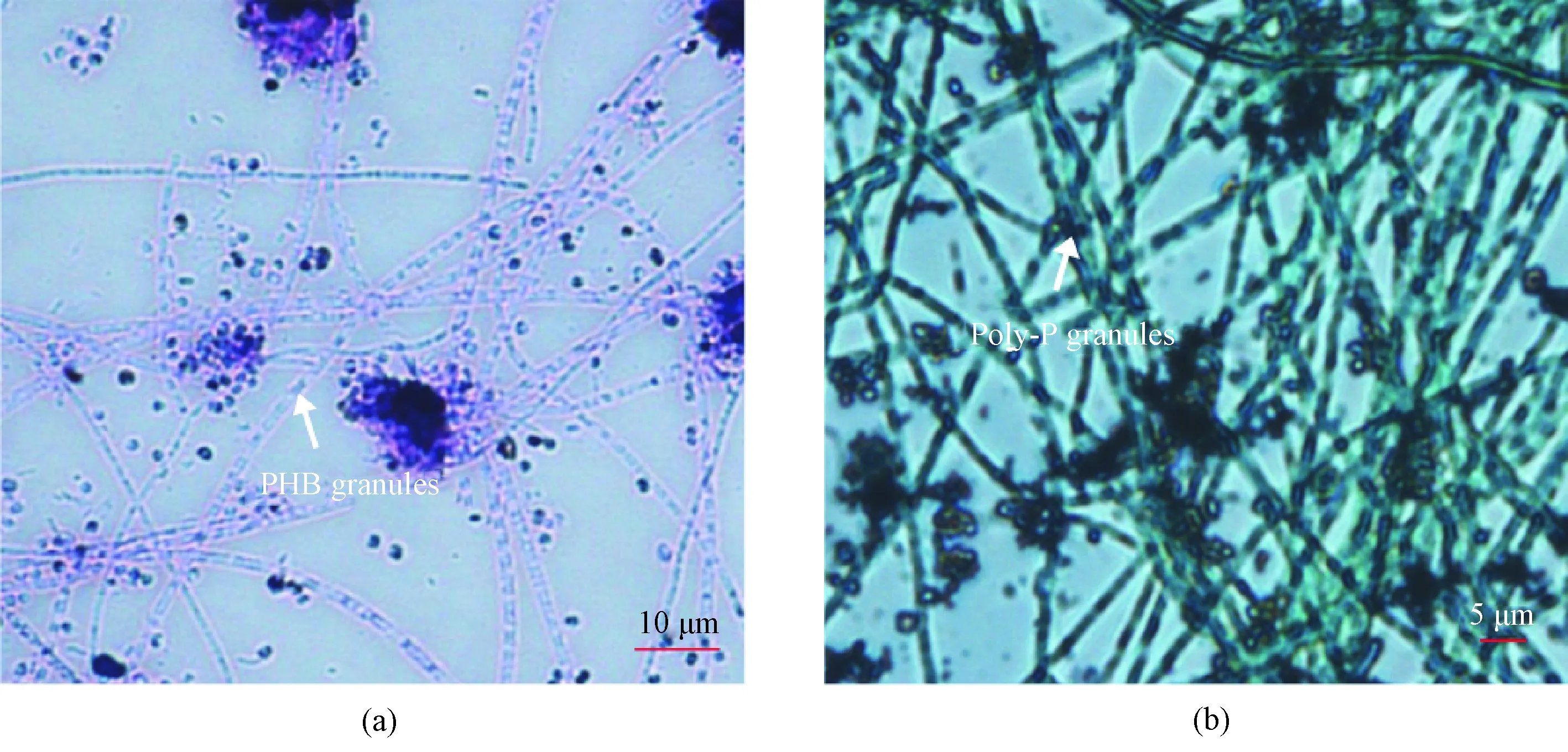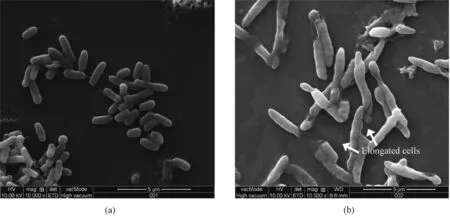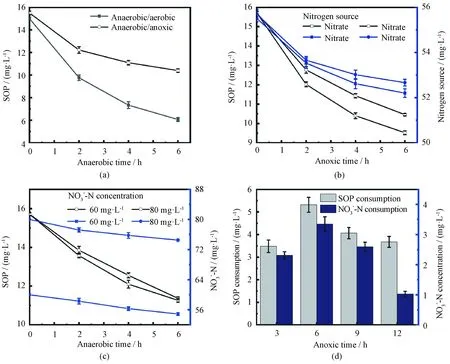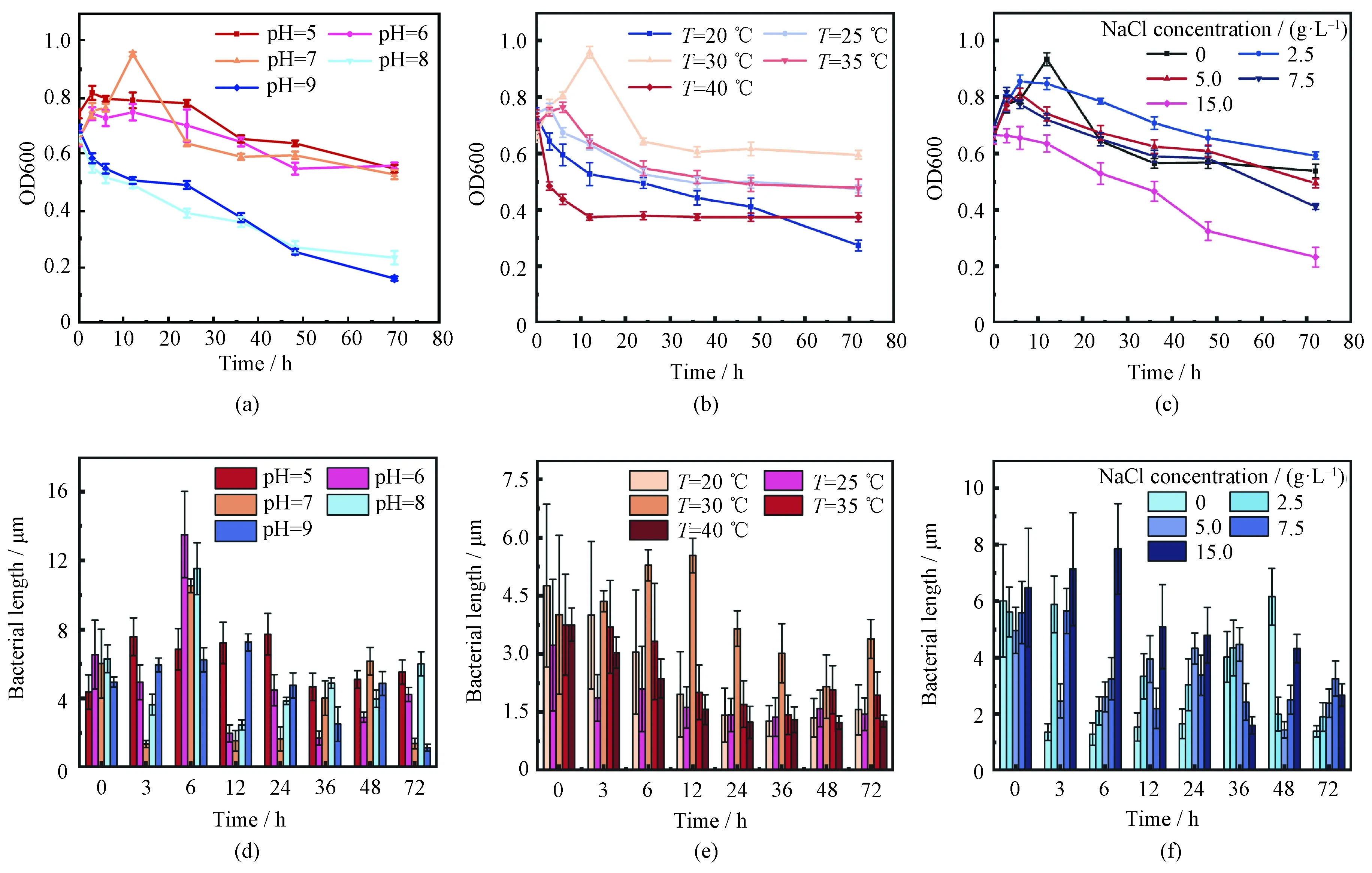Strain Pseudomonas putida PAO-1 Isolate with Polyphosphate Accumulating and Elongation Ability
DONG XuetongTIAN QingZHU Yanbin (朱艷彬) LI Fang (李 方) YANG Bo (楊 波) LIU Yanbiao
College of Environmental Science and Engineering, Donghua University, Shanghai 201620, China
Abstract: Filamentous bacteria (FB) overgrowth is an important cause of sludge bulking in wastewater treatment plants (WWTPs). However, to date, methods for the cultivation and preservation of isolated FB in the laboratory have not been completely described. Furthermore, research on whether FB can function as phosphorus accumulating organisms(PAOs) is limited. In this study, a pure strain, a Pseudomonas putida PAO-1 (P. putida PAO-1) isolate with phosphorus removal functions was isolated from the biofilm of an alternating anaerobic/aerobic biofilter (AABF), and its physiological characteristics were studied. Nitrate or nitrite could be used by the strain P. putida PAO-1 as electron acceptors for denitrification during phosphorus anoxic uptake, and 0.63 mg was consumed to reduce 1 mg soluble orthophosphate (SOP) by P.putida PAO-1. The strain P. putida PAO-1 consumed phosphorus within the optimal pH range of 6 to 8 and the temperature range of 25 ℃ to 35 ℃. Cell deformity was a main morphological trait of the strain P. putida PAO-1, and it could elongate (with an elongation rate of 300%-500%) when it was subjected to oligotrophic or high-salt stress (15 g·L-1 NaCl). The findings in this study provide a microbiological reference for understanding the special characteristics of a denitrifying PAO.
Key words: Pseudomonas putida PAO-1 isolate(P. putida PAO-1); elongation; acclimation; denitrification; phosphorus accumulating organism (PAO)
Introduction
Although morphological plasticity is common strategies for bacteria to the survive under stressed conditions, few people care the special trait of bacteria[1-2]. Morphological plasticity, which means the ability of a bacterial cell shape changing in response to the environment. A typical example of shape change in wastewater treatment is filamentous bacteria (FB, developed from single or swarm cells). FB have features that allow for better growth under conditions lacking macro/micronutrients[3], low dissolved oxygen[4-5], low temperature[6-7], high shear force[8], and low hydraulic retention time[9]. Their emergence is often described as "notorious", because once they grow in large quantities, sludge settlement performance deteriorates, which leads to the loss of activated biomass from conventional wastewater treatment processes[10]. Common FB includeMicrothrixparvicella[11], Type 021N[12]andThiothrix,etc.[13]In addition, there are some bacteria that grow filaments. For example,Pseudomonas(P.) can form filaments at high glutamine concentration[14].
FB require specific growth conditions. However, current research has not fully elucidated the key conditions for the growth and morphological plasticity of FB. It was reported that FB cultured in the laboratory were difficult to preserve, and could not keep their original characteristics (e.g., developing hyphae)[15]. In addition, although many types of FB often presented in the activated sludge of wastewater treatment plants (WWTPs), they were seldom found in other water environments. For example, the representative FBMicrothrixparvicellawas isolated from activated sludge but rivers or river sediments[15].
Furthermore, the ability to store soluble orthophosphates (SOPs) has rarely been reported in some types of FB[16]. Studies have shown that FB can uptake volatile fatty acids (VFAs)[17]in anaerobic/anoxic/aerobic environments to store carbon substances like poly-hydroxyl butyrate (PHB) granules or glycogen in their cells[18-19], which is the metabolic basis for the accumulation of polyphosphate (poly-P). However, to date, it is not clear whether FB can uptake/release phosphorus in alternating anaerobic/aerobic cycles. Some studies suggested that FB could carry out the phosphorus storage process, but the samples in their investigations were taken from bulking sludge, and the scum (or foam of the bioreactors)[20-21]. Samples for future investigation need to be extended to the massive or more stable microbial population in the bioreactor.
In this study, a pure strain ofPseudomonasputidaPAO-1 (P.putidaPAO-1) was isolated, and its physiological characteristics was studied. Then, the denitrifying phosphorus removal capacity of the strain was investigated under alternating anaerobic/aerobic or anaerobic/anoxic conditions. In addition, elongation capacity of the strain was characterized under different cultivation conditions (e.g., varied pH, temperature and NaCl concentration) to characterize its morphological plasticity. This research provides new method or strategy for the cultivation of microorganisms with lengthening and phosphorus accumulating abilities under aerobic/anoxic conditions, and the results of the research expand our knowledge of the deformation conditions for the denitrifying phosphorus accumulating bacteria.
1 Materials and Methods
1.1 Characterization of the biofilm
Samples of biofilm were taken from the alternating anaerobic/aerobic biofilter(AABF) system that had been operated stably for 290 days[22]. The cycling period of AABF was 8 h (anaerobic time: 3 h, aerobic time: 5 h). The influent flow was approximately 3.5 h·L-1, and the hydraulic retention time (HRT) was 50 min.
Biofilm samples (10 mL) were transferred to a 250 mL erlenmeyer flask containing 90 mL of autoclaved water and a plurality of autoclaved glass beads. The biofilms were then mechanically disintegrated under magnetic stirring for 15 min to disperse the individual cells from the biofilm.
1.2 Isolation, purification, and molecular characterization of strain P. putida PAO-1
The bacterial suspension was serially diluted 10-fold over a range of 10-1to 10-7and inoculated onto autoclaved solid isolation medium of the following composition (per liter): 3.68 g CH3COONa·3H2O, 28.73 mg Na2HPO4·2H2O, 57.27 mg NH4Cl, 131.82 mg MgSO4·7H2O, 26.74 mg K2SO4, 17.2 mg CaCl2·2H2O, 2 g HEPES buffer solution, 15 g agar, and 2 mL trace elements[23]. The pH was adjusted to 7 with 1 mol·L-1NaOH. After incubating at 30 ℃ for 1-2 d, the plates with a colony counts ranging from 30-300 were selected, and the colonies on the plates were picked and stored on a solid medium slant at 4 ℃.

Among the isolated strains, those with positive results in both the metachromatic and PHB staining assays and with phosphorus removal rates higher than 50% were selected for the further investigations. The identified strains were inoculated at 30 ℃ into the autoclaved media (composed of 3 g beef extract, 10 g peptone, 5 g NaCl, 0.2 g KH2PO4, and 1 L deionized water). In addition, morphological investigation of the strains was carried out by scanning electron microscopy (SEM) observation (JSM-5600LV, Japan Electronics Co., Ltd., Japan).
When the strain was in logarithmic growth phase, DNA extraction was performed with the TIANamp Bacteria DNA Kit (Tiangen Biotech Co., Ltd., Beijing, China). The bacterial universal primer pairs of 27F/1492R (5'-AGAGT TYGAT CCTGG CTCAG-3'/5'-AAGGA GGTGA TCCAG C CGCA-3') were used for the polymerase chain reaction (PCR) amplification. Then, the PCR product was sequenced by Shanghai Sangon Biological Engineering Technology & Services Co., Ltd., China.
1.3 Acclimation of strain P. putida PAO-1
The enrichment medium [with increased soluble chemical oxygen demand (SCOD) supplementation] was composed of (per liter) 4.92 g CH3COONa, 10 g peptone, 3 g beef extract, 3 g NaCl, 0.16 g NH4Cl, 0.2 g KH2PO4, 0.5 mg FeSO4·7H2O, and 0.377 g MgSO4·7H2O (pH=7). The strain was cultured in enrichment medium for 3-4 rounds (diluted by 100-fold each time) at 30 ℃, 120 r·min-1. After enrichment, the bacterial solution was centrifuged at 10 000 r·min-1for 5 min, 3 times. The supernatant was discarded, and the cells were resuspended in 30 mL autoclaved saline in 50 mL centrifuge tubes. A infrared moisture meter [DHS16 (20)-A, Shanghai Techcomp Instrument Co., Ltd., China] was used to determine the bacterial dry weight concentration of the suspension. Then, the strain suspension was transferred to a 250 mL Erlenmeyer flask containing 100 mL of anaerobic acclimation medium to make a concentrated bacterial suspension with a bacterial cell dry weight concentration of 1-2 g·L-1. The anaerobic acclimation medium (per liter) contained 13.6 g KH2PO4, 0.2 g (NH4)2SO4, 0.5 mg FeSO4·7H2O, 4.92 g CH3COONa, and 0.246 g MgSO4·7H2O. The pH was adjusted to 7.
After the bacteria was cultured for 12 h under anaerobic conditions and after the bacterial suspension was purged with N2gas for 10 min, the suspension was transferred to another 50 mL centrifuge tube. After centrifugation for 5 min at 10 000 r·min-1, the supernatant was discarded and the cells were resuspended in 100 mL aerobic acclimation medium, followed by aeration for 12 h. The aerobic acclimation medium contained components at similar concentrations to the anaerobic acclimation medium without CH3COONa. The above anaerobic/aerobic acclimation was performed in three rounds.
The bacterial suspension (after the first or the last aerobic cultivation) was collected for PHB and poly-P staining and energy dispersive spectrum analysis determination (EDS, IE 300 X, Oxford Instruments, England). The poly-P staining (Albert metachromatic granule straining) samples were then observed by transmission electron microscopy (TEM, JEM-2100, Japan Electronics Co., Ltd., Japan).
1.4 Phosphorus and nitrogen removal assay


1.5 Morphological plasticity assay for P. putida PAO-1 in pure culture
The enriched bacterial solution (without acclimation) was centrifuged as described above, and then the bacterial suspension was transferred into 100 mL aerobic synthetic medium and aerobically incubated for 72 h under different pH (5-9), temperature (20-40 ℃) and salinity (0-15 g·L-1) conditions. The bacterial cell dry weight concentration varied from 1 g·L-1to 2 g·L-1. Uninoculated aerobic synthetic medium was used as the control group. Duplicate cultures were incubated at 30 ℃ on a rotary shaker (170 r·min-1). Bacterial suspensions were taken at regular intervals and the optical density at 600 nm (OD600) of the bacterial suspensions was determined by using an ultraviolet-visible spectrophotometer (UV-7504, Shanghai Xinmao Instrument Co., Ltd., China). Some suspensions were used for poly-P staining and observed with an upright fluorescence microscope (Nikon Eclipse 80i, Nikon Corporation, Japan). The lengths of all the bacteria in the images were measured using the electronically scaled ruler tool provided by Photoshop software, and the average lengths were calculated. Other suspensions were filtered through a 0.22 μm porosity filter, and the phosphate concentration in the supernatant was determined.
2 Results and Discussion
2.1 Isolation and enrichment of strain P. putida PAO-1
In the process of phosphorus bioaccumulation, the amount of phosphorus release or uptake is proportional to the enrichment of phosphorus accumulating organisms (PAOs) in the reactor[24]. Under the phosphorous bioaccumulation stable state in the AABF system, observations were made of the microbial community taxa and the morphology of the biofilm. Large numbers of FB were found in the biomass of the biofilter. The genusP.of theγ-Proteobacteriawas found to be greatly enriched with 98% dominance[25]. Blue-black PHB particles and black intracellular poly-P particles [shown in Figs. 1 (a) and 1 (b)] were observed in the biofilm samples by Sudan black B staining and Albert metachromatic granule staining, confirming the presence of PAOs.
Samples of biofilm were taken from AABF reactor, then were diluted, and inoculated into isolation medium. Milky white, round colonies with a smooth surface were selected, and all single colonies were inoculated onto glucose-MOPS agar plates for incubation (24-48 h). After the conditions of P-limited/P-excess (blue-white screening), the strain with positive PHB staining results and the highest intracellular P content (up to 6%) was selected for further study because the normal intracellular P content in the bacterial cells was about 2%.

Fig. 1 Staining images of biofilm samples of P. putida PAO-1: (a) Sudan black B staining for PHB granules; (b) poly-P staining for poly-P granules
2.2 Physiological and biochemical characteristics
SEM showed that cells of the strainP.putidaPAO-1 were rod-shaped or curved slightly, and the bacterial cells were approximately 1-2 μm in length. The ends of cells were blunt and round, and thin pilus-like strands appeared to connect the individuals [shown in Fig. 2 (a)].
After isolated by blue-white screening, theP.putidaPAO-1 strain was cultivated aerobically without a carbon source before acclimation. It was observed that theP.putidaPAO-1 strain which went through long-term starvation could elongate to 5-7 μm (with an elongation rate of 300%-500%) [shown in Fig. 2 (b)], while the cell length was 1-2 μm when the nutrient levels were sufficient [shown in Fig. 2 (a)]. This characteristic was similar to that of the FBSphaerotilusnatans.Sphaerotilusnatansgrows in the form of dispersed bacilli (abundant nutrients) or as long, sheathed, connected FB (nutrient deprivation)[26]. Therefore, the operation of a bioaccumulating phosphorus reactor could result in the lengthening (or even the existence of filaments) of some PAOs (e.g.,P.putidaPAO-1).

Fig. 2 SEM images for cells of the strain P. putida PAO-1 : (a) individual cells with sufficient nutrient supplement; (b) elongated cells in the case of long-term starvation
2.3 Phylogenetic analysis
A partial 16S rRNA gene ofP.putidaPAO-1 was amplied by the bacterial universal primer pair (27F/1492R) and was directly sequenced from an early-stage culture of the first enrichment step. The results of 16S rRNA gene analysis show that the strain ofP.putidaPAO-1 belongs toP.putidasp. in theγ-Proteobacteriafamily. The 16S rDNA gene sequence of theP.putidaPAO-1 stain had the highest similarity (99%) withP.(at the species level) obtained from the sludge of an improved phosphorus removal process in Songjiang WWTP, Shanghai, China. The strain was named asP.putidaPAO-1 isolate (GenBank accession number-KF591092). The phylogenetic tree (shown in Fig. 3) was built in MEGA X using the neighbor-joining method and the percentage of replicate trees[27]were shown next to the branches while the number of bootstrap replicates was set to 1 000, only bootstrap values(≥50) were shown.

Fig. 3 Phylogenetic position of P. putida PAO-1 strain
2.4 Acclimation
During acclimation (anaerobic time: 12 h, aerobic time: 12 h), the bacterial suspension (after the first and the last aerobic cultivation) was collected for PHB and poly-P staining. As shown in TEM images [shown in Figs. 4 (a) and 4 (d)], phosphate particles did not appear in the bacterial cell cytoplasm before the acclimation process (which were stored at 10 ℃ for 1-2 a), but larger phosphate particles were found within the cell cytoplasm after the acclimation of strain. The black phosphate particles were dense in the vanishing cytoplasmic regions.
After acclimation, approximately 60% of the cytoplasm disappeared. Under certain environmental conditions, the cytoplasm of some bacteria would partially disappear, which might be related to autophagy[28]. Figures 4 (c) and 4 (f) were diagrams of the EDS analyses of the cells before acclimation. No phosphorus spectrum peak was found in Fig. 4 (c), indicating that the phosphorus content of the strain was below the detection limit of the EDS analysis technology. Figure 4 (f) showed the obvious peaks of phosphorus, calcium, and magnesium. It was obvious that the phosphorus content in the biomass increased after the cells were subjected to the anaerobic/aerobic acclimation. Figures 4 (b) and 4 (e) showed that there were more PHB particles in the cells after acclimation.

Fig. 4 TEM images, Sudan black B staining and EDS energy spectrums of the cells of strain P. putida PAO-1: (a) TEM image before acclimation; (b) Sudan black B staining before acclimation; (c) EDS energy spectrums before acclimation; (d) TEM image after acclimation; (e) Sudan black B staining after acclimation; (f) EDS energy spectrums after acclimation
The results of PHB staining, the TEM image analysis and EDS showed that after acclimation, the poly-P components increased significantly. Additionally, the ability ofP.to accumulate phosphate had been described in several studies[29-30], but the strain which was stored for a long time might lose the ability of phosphorus accumulating [shown in Fig. 4 (a)]. Our results indicated that the strainP.putidaPAO-1 had recovered the capacity to accumulate phosphorus in the cells after they were acclimated to the unbalancedC/Nratio substrate under anaerobic conditions and following substrate-limited cultivation under alternating anaerobic/aerobic conditions.
2.5 Phosphorus and nitrogen removal trait of P. putida PAO-1
Some studies suggested that the filaments were capable of nitrification/denitrification, and Feietal.[31]observed thatMicrothrixparvicellacould store poly-P in cells. Gaoetal.[4]achieved shortcut nitrification with the FB Type 0092 as the main nitrifying bacterium. Zhangetal.[32]found thatP.could be heterotrophic nitrifying-aerobic denitrifying bacterium.


Fig. 5 SOP and N removal of P. putida PAO-1: (a) phosphorus uptake curves for the anaerobic/aerobic stages and anaerobic/anoxic stages; (b) nitrogen and phosphorus removal under different nitrogen source (nitrate/nitrite) conditions; (c) nitrate and SOP removal with different initial nitrate concentrations; (d) nitrate and SOP consumption at different anoxic times
2.6 Morphological plasticity of strain P. putida PAO-1
The changes in shape and length of theP.putidaPAO-1 strain were observed under different growth conditions, with the synthetic medium simulating the environments of WWTP. Growth and morphological plasticity experiments were carried out in the pH range of 5 to 9, the temperature range of 20 ℃ to 40 ℃, and the NaCl concentration range of 0 to 15 g·L-1(shown in Fig. 6).
There are some papers on the mechanical properties ofP.biofilms[33-34]. Janaetal.[35]studied nonlinear rheological behavior of biofilms fromP.strains. However, few studies were still focused on the deformation of bacterial length at the microscopic level. To observe the lengthening of individual strains intuitively, all the tests were conducted without a carbon source. The following analyses of individual lengths were carried out within 72 h of strain cultivation. Under different pH conditions, the activity and length ofP.putidaPAO-1 varied with the incubation time, as shown in Figs. 6 (a) and 6(d). When the pH was 6, 7 and 8, the growth activity of theP.putidaPAO-1 strain was higher, and the length of the strain reached its maximum, indicating that the strain lengthens under optimal pH values. When the pH was 5 and 9, the strain was inactive, and its length almost unchanged.

Fig. 6 OD600 and length of the strain P. putida PAO-1 under different pH values, temperatures and NaCl concentrations: (a) OD600 under different pH values; (b) OD600 under different temperatures; (c) OD600 under different NaCl concentrations; (d) length of the cells under different pH values; (e) length of the cells under different temperatures; (f) length of the cells under different NaCl concentrations
As shown in Figs. 6 (b) and 6(e), theP.putidaPAO-1 strain has highest activity and a largest average length at the optimum temperature of 30 ℃. The results indicated that under favorable pH and temperature conditions,P.putidaPAO-1 showed better activity and lengthening capacity. In addition, at the end of testing, the individual cells of the strain were shorter in length. As shown in Figs. 6 (c) and 6(f), the strain's activity decreased with increased NaCl concentration. Compared with the cell length grown under other NaCl concentrations, the average length was the shortest and the activity of the strain was the highest when the NaCl concentration was 0. That is because the higher the NaCl concentration, the greater the osmotic pressure between the intracellular and extracellular environments.
According to the above analysis, the morphology ofP.putidaPAO-1 changed with the external conditions. Under the optimal pH, temperature and high salt conditions, the strain lengthened but retained the ability to shorten back to its original length.
Previous studies have shown thatP.can present as FB in response to different environmental stressing conditions[36]. AlthoughP.putidaPAO-1 did not grow into filaments shape in this study, the elongation phenomenon was observed. The lengthen ability ofP.putidaPAO-1 was studied, which could provide some references for the deformation conditions of FB and how to control or utilize the FB. In current sewage treatment studies, research focused on "inhibition" rather than "utilization" because traditional studies found that FB and nonfilamentous organisms (NFOs) grow together in the form of a floc[26]. Once FB are dominant, sludge shows poor settleability in the system and FB-predominated biomasses are prone to losses in sludge bulking. However, if FB were controlled by aluminum salts[37]or ozone[38]or if they were discharged from the reactor, many potential PAOs may be removed[5]. Although presenting in their filamentous cell types, most FB can tolerate extreme environments (e.g., long-term starvation[39]) and grow faster than NFOs under low temperature conditions[40]. We found that many FB which were most likely to be PAOs (likeP.) appeared in the late stage of the phosphorus bioaccumulation. Cell morphology may not affect sludge biomass morphology[13]and may be influenced by reactor operation. If the growth pattern of FB is changed from suspended growth to attached growth (or their oxidizing or reducing growth conditions and their carbon source availability changes), more PAOs which have lengthening ability can be observed in the reactors. Thus, the potentials of FB can be effectively explored, which probably contribute to effective phosphorus accumulation process with the enhanced system efficiency and stability.
3 Conclusions
The growth traits and denitrifying and phosphorus removal characteristics of the strainP.putidaPAO-1 isolate were investigated. In addition, the trait of morphological plasticity in the strainP.putidaPAO-1 under different environment conditions was uncovered which indicated that phosphorus accumulating bacteria might exist in the form of filaments in the reactor. This study refutes the argument that the beneficial traits of FB cannot be utilized due to their growth mode, and for the enhanced nutrients (nitrogen and phosphorus) removal. We suggest that the focus can be shifted from "curbing" FB growth to conditionally inducing or stimulating FB growth.
 Journal of Donghua University(English Edition)2021年6期
Journal of Donghua University(English Edition)2021年6期
- Journal of Donghua University(English Edition)的其它文章
- Theoretical Model on Transformation Factors of Scientific and Technological Achievements under the Belt and Road Initiative
- Exploitation of Waste Heat from a Solid Oxide Fuel Cell via an Alkali Metal Thermoelectric Converter and Electrochemical Cycles
- Gait Recognition System in Thermal Infrared Night Imaging by Using Deep Convolutional Neural Networks
- Feature Fusion Multi_XMNet Convolution Neural Network for Clothing Image Classification
- Data Augmentation Based Event Detection
- Reduced Switching-Frequency State of Charge Balancing Strategy for Battery Integrated Modular Multilevel Converter
